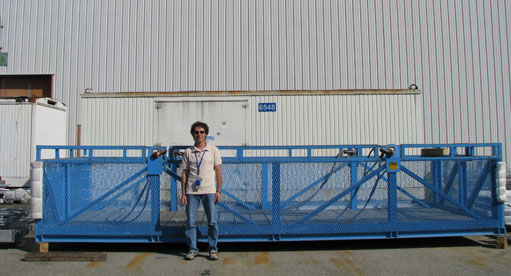
ATLAS e-News
23 February 2011
Cleaning out the cavern
14 July 2008

William Andreazza stands in front of the huge container that was heaped with objects left in the ATLAS cavern
Cleaning the ATLAS cavern is a big job. In a construction site the size of a cathedral, an astonishing amount of clutter can accumulate over six years, 20 cubic metres in William Andreazza’s estimation. He led the effort to get all those loose bits and pieces out of ATLAS for the magnet tests which ran from June 17th to the 22nd.
It started at 9.00 a.m.on June 12th, as 20 collaborators fuelled up on coffee and croissants before heading into the pit. They split into four or five teams, each claiming a region, according to William.
On this first day, the crew removed a few things that should have remained in place – namely, a special covering that protects electronics during testing. “There was some shouting for ten minutes,” says William, but the blankets were returned the same day.
Between June 13th and 21st, a team of three to four people continued to clean ATLAS, including two-hour patrols before the magnet tests that occurred from the 17th to the 22nd. William recalls sounding the alarm on June 18th, to make sure that everyone was out of the cavern before one of the tests began.
“It was weird, to be the last person. You see that we have done something, you see all the detectors,” he reflects.
The clean-up brigade found all manner of tools, parts, and electronics. “I guess at the end of the day, we were able to open a shop,” William says with a smile, as he reckons that the various parts that they found could account for 40-50 per cent of an engineer’s catalogue.
And he made a point of continuing to smile after hours and hours of crawling through tight spaces and finding creative ways to remove ladders that had been forgotten long before the cavern was so full.
All the climbing among ATLAS’s eight levels was something of a physical work-out, and William drank three litres of water some days. In the evenings, he and his team emerged covered in sweat and black metal dust.
For all the crawling that he did, he tips his hat to the two-man team that spent April and May on their hands and knees, vacuuming out the toroid magnet system. He ordered knee pads for them, like those used for volleyball players. The toes of their safety shoes, new at the start, were in tatters after just one month.
William’s team focused on larger objects, ranging from screws to thick honeycomb pads approaching the size of a twin mattress, which protected parts of ATLAS from falling objects. In the bottom sectors of the detector, small parts such as bolts, washers, and cable ties had pooled to depths of up to 10 centimetres.
Cellular phones were notoriously missing from the found objects. “Many colleagues, when they knew we were about to start cleaning, they said, ‘Okay, I lost my phone in there three or four months ago over there,’” says William. “We didn’t find any.” He’s convinced that the small, dark Nokias will remain forever lost.
William sets the value of the objects removed from ATLAS at 30,000-40,000 Swiss francs. “One can see where part of the budget has gone,” he laughs, but he points out that the team spent hours sorting the material so that some of it may be used later on.
This is neither the first nor will it be the last major clean-up in ATLAS, the most recent of which occured last December. William expects another large clean-up effort in August before the last set of magnet tests. However, if those of you working in the pit want to do your bit to help out the cleaning crew, please take your equipment out of the pit with you when you leave, every day.
